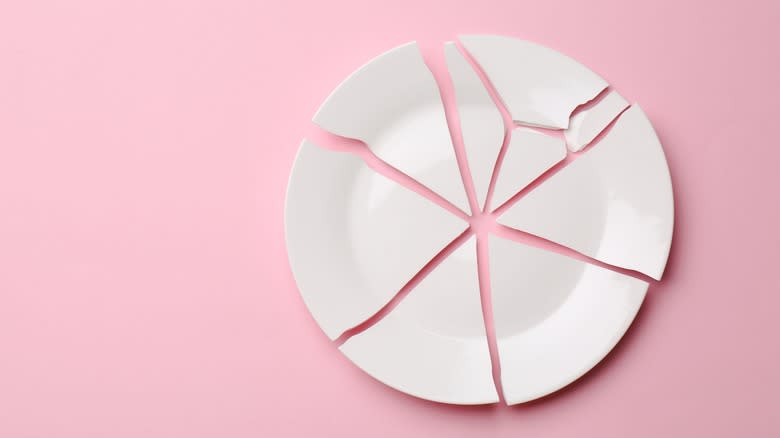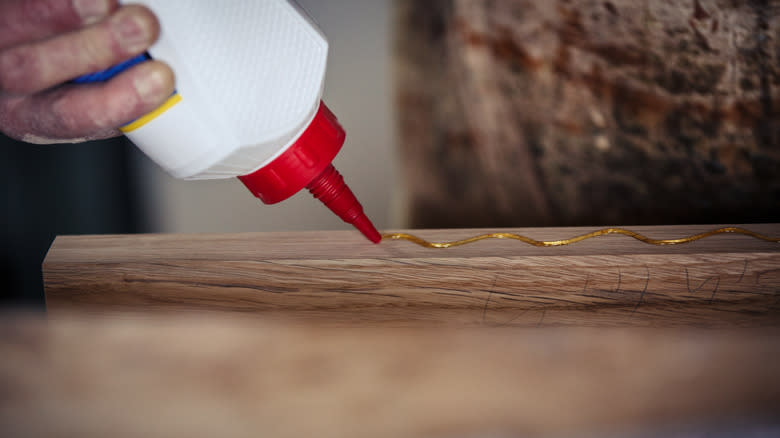Can You Really Fix Cracked Dishes With Milk?

There's nothing worse than accidentally dropping a plate or bowl, only to have it break into multiple pieces. Even if you're careful, your dishes can chip from standard wear and tear. So, what is one to do? Well, if you believe the persuasive power of the internet, kitchen hacks would have you reaching for a gallon of milk.
However, results may vary on whether milk can fix those cracked dishes. Southern Living swears by the method, displaying the repairing properties of milk in its list of clever milk hacks. The method is as simple as holding the cracked plates and bowls together with rubber bands and placing them in a pot of heated milk. If it works like it's supposed to, then the dish will be melded back together after the hack. However, people who have tried the hack have had little success, with some on Reddit calling the trick as little more than an internet myth. One person wrote on Reddit, "How do things like this even gain traction? Warm milk has fixing properties? Huh?"
A couple of testers put the hack to the test by breaking a ceramic plate in half. To their disappointment, the plate failed to bond back together after being set in milk.
Read more: 14 Liquids To Add To Scrambled Eggs (And What They Do)
The Questionable Science Behind Milk

So why do some believe that milk can fix cracked dishes? Well, it's due to the fact milk contains a phosphoprotein called casein. Casein also appears in a number of glues, so it only makes sense that it could act as a binding agent in milk, right? Unfortunately, that's a misrepresentation. Just because milk contains casein doesn't make it adhesive. Generally, casein is combined with several other ingredients to make glues. Likewise, milk isn't just casein. It's a mixture of water as well as other proteins and vitamins, which means it's not going to be adhesive like a stronger concentration of casein.
If milk had strong adhesive properties, then it probably wouldn't be good for consumption. There's a reason that it's advisable not to eat glue, as glue can cause a potential blockage in the gastric tract. You don't see many having issues like this with drinking milk, with lactose intolerance being the main problem for some. Likewise, the milk hack falsely leads people to believe that the proteins in milk can bind together ceramic. However, there may be some truth to this hack as you can make glue using milk, but it doesn't work in the same way, as this hack demonstrates.
Making A Homemade Glue

While it's fairly easy to make a casein glue at home, you will need some other ingredients besides just milk. Namely, you'll want both vinegar and baking soda -- which may bring to mind the memory of those grade school science fairs. Milk of magnesia or calcium carbonate may also work instead of baking soda. You will want to heat the milk and mix in the vinegar, which will cause the milk to curdle. This will separate the solids from the liquids.
The reason that the milk begins to separate is due a chemical reaction in which the vinegar promotes casein to form interlinking chains. You can discard the liquid as the curds, when mixed with water and baking soda or another base will form your glue. An important thing to remember is that you should probably use skim milk instead of whole milk. The higher fat content in whole milk will prevent the chemical reaction needed to form the curds. Likewise, you want to avoid overheating your milk. It should be warm, not boiling.
Casein glue is relatively cost-effective to make, but it seems to work best with wood and paper. For ceramics, you may want to opt for a different glue instead.
Read the original article on Daily Meal.


